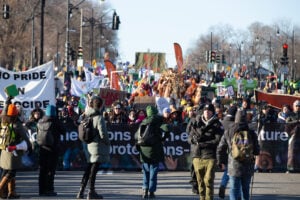
Environment
Inside the fight to protect the Arctic’s “Water Heart”
How the Sahtuto’ine Dene of Déline created the Tsá Tué Biosphere Reserve, the world’s first such UNESCO site managed by an Indigenous community
- 1693 words
- 7 minutes
People & Culture
We caught up with Indigenous filmmaker Sarain Fox to talk Giiwewizh — a series of 16 short films directed and shot in isolation on iPhone 12

Gentle notes strum on a guitar, as a boat glides across the waters of Nuu-chah-nulth territory in British Columbia, where musician Hasaatuk’s ancestors have lived for thousands of years. As her voice rings out, loud and vibrant like her namesake, Hasaatuk showcases not just her music, but the land she lives on, and her father who taught her how to play guitar.
The video is just one of 16 films directed by filmmaker Sarain Fox for this year’s International Indigenous Music Summit, which began airing last night. The series is called Giiwewizh — meaning “to carry home” in Ojibway Anishinaabe — and was created in isolation by Indigenous artists attending the summit.
Are you passionate about Canadian geography?
You can support Canadian Geographic in 3 ways:

Environment
How the Sahtuto’ine Dene of Déline created the Tsá Tué Biosphere Reserve, the world’s first such UNESCO site managed by an Indigenous community

People & Culture
Indigenous knowledge allowed ecosystems to thrive for millennia — and now it’s finally being recognized as integral in solving the world’s biodiversity crisis. What part did it play in COP15?

History
A look back at the early years of the 350-year-old institution that once claimed a vast portion of the globe

People & Culture
The story of how a critically endangered Indigenous language can be saved